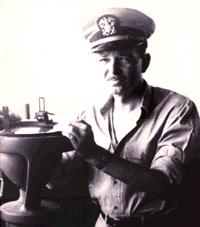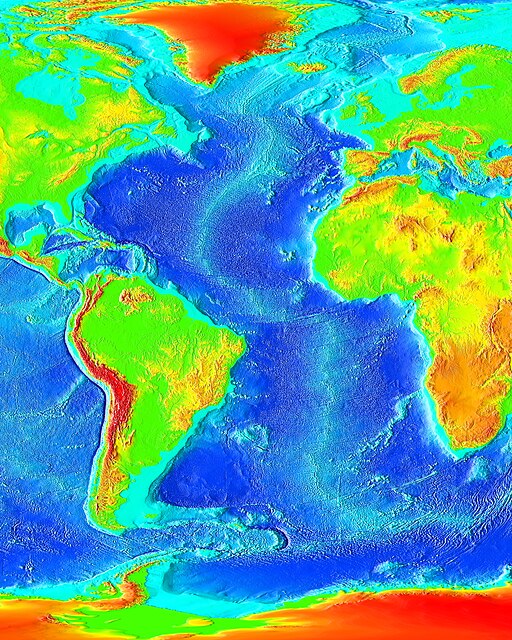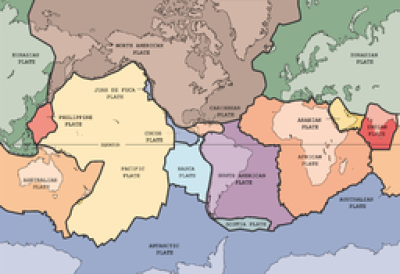Course description
The Earth Moves – Tectonic Plates & Continental Drift
 In 1908, an amateur American geologist named Frank Bursley Taylor thought – rightly – that continents moved and their crashing together could have pushed up the world’s mountains. He noticed that some continents were shaped very similarly to others so that, for example, South America might have been fitted to Africa like a jigsaw puzzle, and so on. He did not produce much evidence though and the theory was considered too crazy for serious attention.
In 1908, an amateur American geologist named Frank Bursley Taylor thought – rightly – that continents moved and their crashing together could have pushed up the world’s mountains. He noticed that some continents were shaped very similarly to others so that, for example, South America might have been fitted to Africa like a jigsaw puzzle, and so on. He did not produce much evidence though and the theory was considered too crazy for serious attention.
In Germany, however, Taylor’s idea was picked up by a theorist named Alfred Wegener, a meteorologist at the University of Marburg. Wegener investigated the many plants and fossils that did not fit comfortably into the standard model of Earth history. Animal fossils repeatedly turned up on opposite sides of oceans that were too wide to swim. How, he wondered, did marsupials travel from South America to Australia? How did snails turn up in Scandinavia and the US?
 Wegener developed the theory that the world’s continents had once come together in a single landmass he called Pangaea, where flora and fauna mixed, before the continents split apart and floated to their present positions. All this he put together in a book, which was published in German in 1912 and – despite the First World War – in English three years later.
Wegener developed the theory that the world’s continents had once come together in a single landmass he called Pangaea, where flora and fauna mixed, before the continents split apart and floated to their present positions. All this he put together in a book, which was published in German in 1912 and – despite the First World War – in English three years later.
Wegener’s theory didn’t attract much notice at first, but by 1920, when he produced an expanded edition, it quickly became a hot talking point. Everyone agreed that continents moved – but up and down, not sideways. Clearly the time was ripe for a new theory. Unfortunately, Alfred Wegener was not the man that geologists wished to provide it.
For a start, his radical notions questioned the foundations of geology, not the best way to warm up an audience. This would have been painful from a geologist, but Wegener had no background in geology. He was a meteorologist. A weatherman—a German weatherman.
 And so geologists rejected his evidence and belittled his suggestions. To get around the problems of fossil distribution, they had the idea of ancient ‘land bridges’ wherever they were needed. When an ancient horse was found in France and Florida at the same time, a land bridge was drawn across the Atlantic. When it was realized that ancient tapirs had existed simultaneously in South America and Southeast Asia a land bridge was drawn there, too. Soon maps of prehistoric seas were almost solid with land bridges. These not only conveniently appeared when necessary to move a living organism from one landmass to another, but then vanished without a trace. None of this, of course, was supported by actual evidence, yet it was the religion of geology for the next half century.
And so geologists rejected his evidence and belittled his suggestions. To get around the problems of fossil distribution, they had the idea of ancient ‘land bridges’ wherever they were needed. When an ancient horse was found in France and Florida at the same time, a land bridge was drawn across the Atlantic. When it was realized that ancient tapirs had existed simultaneously in South America and Southeast Asia a land bridge was drawn there, too. Soon maps of prehistoric seas were almost solid with land bridges. These not only conveniently appeared when necessary to move a living organism from one landmass to another, but then vanished without a trace. None of this, of course, was supported by actual evidence, yet it was the religion of geology for the next half century.
To be sure, Wegener made mistakes. He said that Greenland was drifting west by about a mile a year, which is nonsense. (It’s more like half an inch.) Above all, he could offer no explanation for how landmasses moved about. To believe in his theory you had to accept that massive continents somehow pushed through solid crust, without leaving any sign of the movement afterwards. What motored these movements?
 It was Arthur Holmes, the English geologist who discovered the Earth’s age, who suggested a way. Holmes was the first to understand that radioactive warming could produce convection currents in the Earth. In theory, these could be powerful enough to move continents around on the surface. Holmes suggested a continental drift theory similar to today’s. It was still radical for the time and widely criticized. However, the new theory also drew steady if careful support.
It was Arthur Holmes, the English geologist who discovered the Earth’s age, who suggested a way. Holmes was the first to understand that radioactive warming could produce convection currents in the Earth. In theory, these could be powerful enough to move continents around on the surface. Holmes suggested a continental drift theory similar to today’s. It was still radical for the time and widely criticized. However, the new theory also drew steady if careful support.
Interestingly, oil company geologists had known for years that if you wanted to find oil you had to allow for precisely the sort of surface movements that were made by plate tectonics. But oil geologists didn’t write academic papers; they just found oil.
There was another problem with Earth theories no-one had solved. That was the question of where all the sediment went. Every year, Earth’s rivers carried massive volumes of eroded material – 500 million tons of calcium, for instance – to the seas. If you multiplied this rate by the number of years it had been going on, there should be about twelve miles of sediment on the ocean bottoms – or, put another way, the ocean bottoms should be well above the ocean tops. Scientists ignored it.
 In the Second World War, a Princeton University mineralogist named Harry Hess was in charge of an attack ship. On this was a new depth sounder, called a fathometer, which, Hess realized, could equally well be used for scientific purposes and never switched it off. What he found was entirely unexpected. If the ocean floors were ancient, as everyone assumed, they should be covered with sediment, like the mud on the bottom of a river. But Hess’s readings showed there were canyons, trenches, and volcanoes. All this was odd, but Hess had a war to fight, and stored such thoughts at the back of his mind.
In the Second World War, a Princeton University mineralogist named Harry Hess was in charge of an attack ship. On this was a new depth sounder, called a fathometer, which, Hess realized, could equally well be used for scientific purposes and never switched it off. What he found was entirely unexpected. If the ocean floors were ancient, as everyone assumed, they should be covered with sediment, like the mud on the bottom of a river. But Hess’s readings showed there were canyons, trenches, and volcanoes. All this was odd, but Hess had a war to fight, and stored such thoughts at the back of his mind.
After the war, Hess returned to Princeton, but the mysteries of the seafloor continued to occupy his thoughts. Meanwhile, throughout the 1950s, oceanographers were doing more and more complicated surveys of the ocean floors. In doing so, they had an even bigger surprise: the largest and longest mountain range on Earth was – mostly – underwater. It was a continuous path along the world’s seabeds, rather like the stitches on a cricket ball. If you began at Iceland, you could follow it down the center of the Atlantic Ocean, around the bottom of Africa, and across the Indian and Southern Oceans, below Australia; there it turned across to the Pacific before shooting up the west coast of the United States to Alaska. Occasionally its higher peaks rose above the water as an island, like the Azores and Canaries in the Atlantic, Hawaii in the Pacific, for instance – but mostly it was under thousands of feet of salty sea. The network extended to 46,600 miles.
 Then, in 1960, samples showed the ocean floor was quite young at the mid-Atlantic ridge but grew older as you moved away from it. Harry Hess considered the matter and realized that this could mean only one thing: new ocean crust was being formed on both sides of the central rift, then being pushed away from it as new crust came along behind. The Atlantic floor was carrying crust toward North America and Europe. The process became known as seafloor spreading.
Then, in 1960, samples showed the ocean floor was quite young at the mid-Atlantic ridge but grew older as you moved away from it. Harry Hess considered the matter and realized that this could mean only one thing: new ocean crust was being formed on both sides of the central rift, then being pushed away from it as new crust came along behind. The Atlantic floor was carrying crust toward North America and Europe. The process became known as seafloor spreading.
When the crust reached the end of its journey at the continents, it dived back into the Earth in a process known as subduction. That explained where all the sediment went. It was being returned to Earth’s interior. It also explained why ocean floors everywhere were so young. None was found to be older than about 175 million years, which was odd because continental rocks were often billions of years old. Now Hess could see why. Ocean rocks lasted only as long as it took them to travel to shore. It was a beautiful theory that explained a great deal. Hess elaborated his ideas in an important paper, which was ignored. Sometimes the world just isn’t ready for a good idea.
It finally fell to two men from Cambridge University, a geophysicist named Drummond Matthews and a graduate student, Fred Vine, to draw all the strands together. In 1963, using magnetic studies of the Atlantic Ocean floor, they showed conclusively that the seafloors were spreading in precisely the manner Hess had suggested and that the continents were moving too.
Mobile crust was an idea whose time had finally come.
 Today we know that Earth’s surface is made up of eight to twelve big plates and twenty or so smaller ones, and they all move in different directions and at different speeds. Some plates are large and inactive, others small but energetic. They have only an accidental relationship to the landmasses that sit on them. The North American plate, for instance, is much larger than the continent it’s associated with. Iceland is split down the middle, which makes it tectonically half American and half European. New Zealand, meanwhile, is part of the immense Indian Ocean plate even though it is nowhere near the Indian Ocean. And so it goes for most plates.
Today we know that Earth’s surface is made up of eight to twelve big plates and twenty or so smaller ones, and they all move in different directions and at different speeds. Some plates are large and inactive, others small but energetic. They have only an accidental relationship to the landmasses that sit on them. The North American plate, for instance, is much larger than the continent it’s associated with. Iceland is split down the middle, which makes it tectonically half American and half European. New Zealand, meanwhile, is part of the immense Indian Ocean plate even though it is nowhere near the Indian Ocean. And so it goes for most plates.
The connections between modern landmasses and those of the past were found to be much, much more complex than anyone had imagined. Kazakhstan, it turns out, was once attached to Norway and the US. One corner of Staten Island, but only a corner, is European. So is part of Newfoundland. Pick up a pebble from a Massachusetts beach, and its nearest relative will now be in Africa. Rocks, in short, get around.
The constant movement keeps the plates from fusing into a single immobile one. If things continue as at present, the Atlantic Ocean will expand until eventually it is much bigger than the Pacific. Much of California will float off and become an island in the Pacific. Africa will push northward into Europe, pushing the Mediterranean out of existence and throwing up a chain of mountains from Paris to Calcutta. These are future outcomes, but not future events. The events are happening now. As we sit here, we can see that Europe and North America are parting at about the speed a fingernail grows —roughly two yards in a human lifetime. Look at a globe and what you are seeing really is a snapshot of the continents as they have been for just one-tenth of 1% of Earth’s history.
Alfred Wegener never lived to see his ideas proved right. On an expedition to Greenland in 1930, he set out alone, on his fiftieth birthday, to check out supplies. He never returned. He was found a few days later, frozen to death on the ice. He was buried on that spot and lies there now, but about a yard closer to North America than on the day he died.
If you want to watch some videos on this topic, you can click on the links to YouTube videos below.
If you want to answer questions on this article to test how much you understand, you can click on the green box: Finished Reading?
Videos :
1. Continental Drift (2:00)
2. Continental Drift 2 (11:00)
3. Plate Tectonics (3:00)
4. Alfred Wegener (5:00)
5. Pangaea (8:00)
6. The Land Bridge (2:00)
7. Arthur Holmes (2:00)
8. Ocean Floor (5:00)
9. Vine and Matthews (2:00)
10. Vine and Matthews 2 (2:30)
11. Landmasses and Oceans (2:00)

 In 1908, an
In 1908, an Wegener developed the theory that the world’s continents had once come together in a single landmass he called Pangaea, where
Wegener developed the theory that the world’s continents had once come together in a single landmass he called Pangaea, where  And so geologists
And so geologists  It was Arthur Holmes, the English geologist who discovered the Earth’s age, who suggested a way. Holmes was the first to understand that radioactive warming could produce
It was Arthur Holmes, the English geologist who discovered the Earth’s age, who suggested a way. Holmes was the first to understand that radioactive warming could produce In the Second World War, a Princeton University mineralogist named Harry Hess was in charge of an attack ship. On this was a new
In the Second World War, a Princeton University mineralogist named Harry Hess was in charge of an attack ship. On this was a new  Then, in 1960, samples showed the ocean floor was quite young at the mid-Atlantic ridge but grew older as you moved away from it. Harry Hess considered the matter and realized that this could mean only one thing: new ocean crust was being
Then, in 1960, samples showed the ocean floor was quite young at the mid-Atlantic ridge but grew older as you moved away from it. Harry Hess considered the matter and realized that this could mean only one thing: new ocean crust was being Today we know that Earth’s surface is made up of eight to twelve big plates and twenty or so smaller ones, and they all move in different directions and at different speeds. Some plates are large and inactive, others small but energetic. They have only an accidental relationship to the landmasses that sit on them. The North American plate, for instance, is much larger than the continent it’s associated with. Iceland is split down the middle, which makes it tectonically half American and half European. New Zealand, meanwhile, is part of the immense Indian Ocean plate even though it is nowhere near the Indian Ocean. And so it goes for most plates.
Today we know that Earth’s surface is made up of eight to twelve big plates and twenty or so smaller ones, and they all move in different directions and at different speeds. Some plates are large and inactive, others small but energetic. They have only an accidental relationship to the landmasses that sit on them. The North American plate, for instance, is much larger than the continent it’s associated with. Iceland is split down the middle, which makes it tectonically half American and half European. New Zealand, meanwhile, is part of the immense Indian Ocean plate even though it is nowhere near the Indian Ocean. And so it goes for most plates.
















